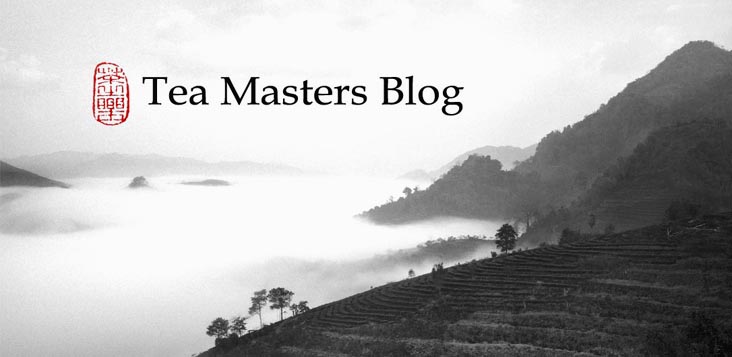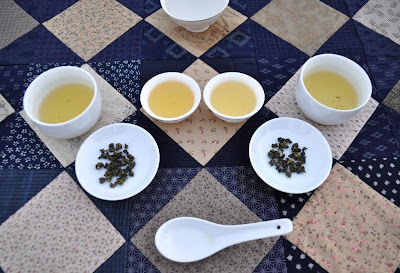Cultivar: Luanze Oolong
Origin: Feng Huang, Dong Ding, Taiwan
Harvested by hand in spring 1980
Process: Hung Shui Oolong
Aging: by a tea collector in a jar. Except for its original medium charcoal roast in 1980, this tea hasn't been roasted again.
The dry leaves are typical for real aged Oolong: they are not as tightly rolled anymore. With time, the leaves tend to open up a little. Also, their color is brown, but not black, because it hasn't been overly roasted.
(Note that the 'splendidly beautiful' pine and bamboo Cha Bu is available again! This time, the second side is black. The dimensions are 52 x 28.5 cm = small size only.)
To brew these few old leaves, I'm using a top quality Shui Ping zhuni teapot (shown yesterday) made in the 1980s. The zhuni clay gets the most out of rolled leaves, because its high iron content keeps the teapot hot very long. And its hard walls are less porous, which explains why they absorb less flavors than other clays. But the difference with silver (which is hotter and not porous at all) is that the clay interacts with the tea and refines, purifies it and adds a longer aftertaste.
1. In spring 1980, this traditional Dong Ding Oolong was the best and most sought after tea in Taiwan. High mountain Oolongs had not appeared yet. Feng Huang, the highest elevation in the Dong Ding area, was at the top of its fame. In terms of purchasing power, the prices were similar to Da Yu Ling Oolong today! And that's why the best tea makers used all their skills to produce the very best tea possible. High standard.
2. Low to medium oxidation of the leaves and slow, long baking of the leaves were distinctive characteristics of these Dong Ding Oolongs. We also call them Hung Shui Oolongs, or red water oolongs. But, actually the color of the brew tends rather to be golden, with hints of brown.
3. In tea auctions in China, similar 30 years old Dong Ding Oolongs have reached the price of gold!!! At today's valuation of gold (1711 USD for 1 ounce), this translates into 60 USD per gram! Hence, this is the gold standard of Oolong tea! (I've noted before that this price level isn't unheard of: 80 years of puerh can cost 3 times as much or more).
There is even a fourth reason to call it the 'gold standard'. This tea tastes unbelievably good. It's not sparkling like a diamond, but it's powerful and peaceful. The scents are complex and elegant, a mix of dark malt whiskey, old wood, chocolate and ripe fruits. The taste is luscious and thick, while completely clean, pure and sweet. The first brews unleash a powerful cha qi that warms my whole body. At the same time, it feels very well balanced and after a couple of brews there are also more and more hints of freshness and 'green' feelings. This tea still very much feels alive and its aftertaste is continuously playing in the mouth. One cup calls for another.
Here are some leaves, taken after 4 brews. I later put them back into the teapot to continue brewing this tea for 2 days!
The more often I brew, the more the leaves open up and their color turns more and more towards green. The tea still feels very rich, sweet and soothing. As I smell again the dry leaves in their pewter tea caddy, I am reminded of the scent of Christmas cookies with some anise and ginger.
This experience is like R&D for me. It helps me define what is top quality and what qualities to search for in young (and more affordable) teas. It's not something I drink often. It is much more a tea for special occasions.
For instance, I was thinking this would be a great tea for a Republican to celebrate a Mitt Romney victory in a week. Why? (Let's have some bipartisan fun now):
1. Drinking a good tea to celebrate the victory of the candidate supported by the tea party!
2. 1980 is the year Ronald Reagan was elected!
3. Mitt Romney appears less modern (high mountain oolong) and more the traditional kind (Dong Ding).
4. Only the 1% can afford this tea!
5. Besides, some in the tea party also want a return to some kind of a gold standard to strengthen the dollar. (Writing this article made me realize how gold increased from 26 USD per gram in January 2009 to now 60 USD per gram!)
And what about an Obama victory? The race seems very close. Here, I hesitate between recommending several teas:
- A winter 2008 high mountain Da Yu Ling Oolong. This is a more modern tea, made when Obama won his first term. No matter what, this tea always keeps its cool. And Da Yu Ling farmers think very highly of their tea. However, it's not very affordable and it would not age well for 4 more years!
- A 1976 cooked brick (7638), one of the first black (shu) puerh as a symbol for the first black president. It won't change much over time. The next four year would be like the last four. This used to be an affordable tea, at least. Maybe we could borrow some from China, says the Fed! 1976 was also the year Jimmy Carter won... Oops!
Disclaimer: I am French and can't vote in the US elections. All the above jokes were supposed to be moderately funny and were not aimed at changing the opinions of swing State voters!




























































